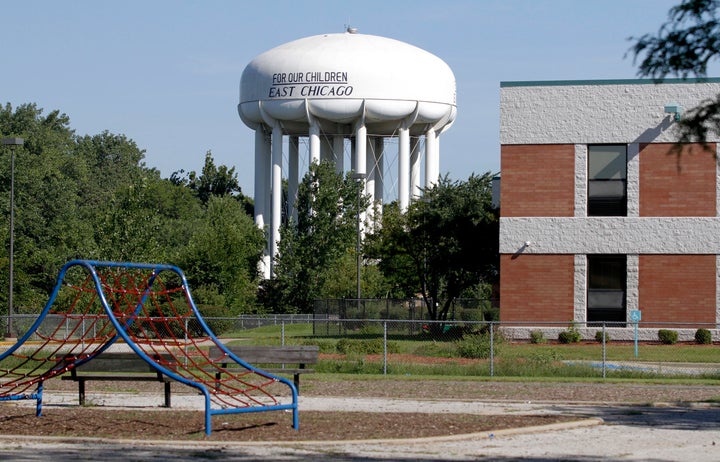Childhood lead experts across the country panned a federal action plan to reduce childhood lead exposure that the Trump administration unveiled on Wednesday, criticizing the strategy’s shortcomings, including its failure to commit to the elimination of lead poisoning, update federal standards and regulations with concrete timelines, and specify funding sources to implement its goals.
Environmental Protection Agency Acting Administrator Andrew Wheeler described the plan as a roadmap to reduce lead exposure nationwide. It has four primary goals: identifying lead-exposed children, reducing children’s exposure to lead sources, communicating more effectively with stakeholders, and conducting research to inform these efforts.
“Lead exposure is a calamity that disproportionately harms children in low-income communities. All Americans, regardless of their age, race, income or home address, deserve an opportunity to live in safe and healthy environments,” Wheeler, co-chair of the President’s Task Force on Environmental Health Risks and Safety Risks to Children, told reporters Wednesday.
The task force was established by executive order in 1997 and comprises 17 federal departments and offices, including the EPA and the Department of Health and Human Services. Wheeler said the plan includes specific action targeting lead in paint, drinking water, contaminated soil and consumer products before it presents a “serious and urgent threat” to children.
But childhood lead experts and advocates who reviewed the action plan said it falls far short of what’s needed to eliminate the risk of childhood lead exposure.
“It’s a significant step backward in progress to end lead poisoning for children in the United States,” said attorney and health justice scholar Emily Benfer, a visiting associate clinical professor of law at Columbia University Law School who directs the health justice advocacy clinic.
“This task force is talking about simply reducing exposure and not taking any concrete steps to actually make that happen. And without a dedicated funding stream, it’s really just talk.”
- Emily Benfer, Columbia University Law School
The task force’s 2016 report included primary prevention, environmental justice, and the elimination of lead poisoning, but none of those themes are included in the current action plan, Benfer said, noting it doesn’t use the word “eliminate” at all.
“Two years ago, the task force said that the goal was to eliminate lead poisoning and to realize environmental justice especially for high-risk communities,” she said. “This task force is talking about simply reducing exposure and not taking any concrete steps to actually make that happen. And without a dedicated funding stream, it’s really just talk.”
Benfer is particularly concerned that the plan often mentions the task force’s intent to evaluate or re-evaluate lead contamination issues that have already been studied, researched and widely understood in the scientific community as being harmful to human health.
For example, the dangers of lead in aviation fuel, the single largest source of lead in the air, said Benfer, is an issue that requires action, not more evaluation, to protect children in low-income communities who are most affected by ambient air pollution.
The action plan even recommends more evaluation of the blood lead reference level at which the Centers for Disease Control and Prevention recommends public health intervention for children. The CDC has already concluded that no level of lead in children is safe, and may reduce the reference level from 5 to 3.5 micrograms per deciliter based on scientific recommendations.
“So while they’re busy considering and exploring — those are the themes of the report — how many millions more children are going to suffer from the permanent brain damage due to lead poisoning?” Benfer asked.
“This really doesn’t advance lead poisoning prevention in any way,” she added.

Ruth Ann Norton, president and chief executive officer of the Green & Healthy Homes Initiative in Baltimore, commended the task force for producing a comprehensive report and for emphasizing the urgency of taking action to address what she described as one of the most tragic and costly environmental diseases in the United States.
But the plan is too broad, she said, and lacks details on one of the most important questions to implement the strategy: funding.
“They clearly support the fact that lead is an entirely preventable and winnable issue ... but it does not address the most urgent, pressing need, which is the capital investment to eliminate this issue,” Norton told HuffPost.
The action plan is not a budget document and notes that all of its activities are “subject to budgetary constraints, interagency processes, stakeholder input and other approvals.” This includes how the Trump administration weighs priorities and available resources, and how Congress appropriates funding, it explains.
Although blood lead levels in U.S. children have dropped dramatically in the last 30 years, lead continues to plague communities across the country, particularly low-income neighborhoods. Approximately half a million U.S. children in the United States have blood lead levels above the level at which the Centers for Disease Control and Prevention recommends intervention.
In a statement to HuffPost, Erik Olson, senior director of health and food for the international nonprofit Natural Resources Defense Council, also criticized the action plan for failing to commit to regulatory or enforcement action.
“Lead is one of our most toxic pollutants, and it’s in our air, waters and lands. And children are our most vulnerable population. Given this administration’s abysmal track record on protecting public health, we remain skeptical,” Olson said in a statement from NRDC.
The plan outlines that the EPA will consider revisions to lead dust hazard standards from paint, as appropriate. But Olson points out that the agency is under a court order to strengthen outdated lead hazard standards by July 2019.
“‘Considering’ complying with a court order doesn’t cut it,” wrote Olson.
He noted that the EPA’s July 2018 proposal on lead paint dust hazard standards did tighten the standards, but not as much as public health experts have recommended.
“'Considering’ complying with a court order doesn’t cut it.”
- Erik Olson, Natural Resources Defense Council
Olson also took issue with the types of stakeholders involved in the process to revise the EPA’s Lead and Copper Rule, which the agency had proposed to strengthen by December 2017, then delayed to spring 2019.
The rule, which hasn’t been updated in more than two decades, establishes the guidelines for how local jurisdictions must manage their water systems to reduce lead and copper pipe contamination.
The task force says it plans to move forward on the rule with input from “from state, tribal, and local partners.” But Olson points out that public health advocates, environmental groups and others aren’t explicitly mentioned.
Experts also recommend primary prevention to eliminate environmental hazards at the source. The task force’s goals, however, place an emphasis on identifying lead-exposed children, which is the opposite of primary prevention, said Benfer.
“They talk about the need to facilitate follow-up blood lead level testing and monitoring but they disregard the fact that the majority of states require zero intervention until lead levels are past 10, 15, 20 even 45 micrograms per deciliter,” said Benfer. “So without this widespread effort to really provide guidance with the goal of primary prevention, we’re going to continue placing children in harm’s way.”
Norton, with the Green & Healthy Homes Initiative in Maryland, says the elimination of lead poisoning through primary prevention, universal blood testing and other concrete steps is achievable in five years but would require an investment of $12.5 billion over a five-year period. Her organization published a 2016 report that outlines a strategy to marshal the financial resources to end childhood lead exposure.
In the long run, spending this money to prevent lead exposure will save the nation more than $250 billion over five years, Norton said, noting that the United States spends approximately $50 billion every year on the avoidable cost of treating hundreds of thousands of poisoned and lead-exposed children.
“The realities are that we are paying a price for a toxic legacy that has impaired the opportunities of American children for generations, and most especially African-American children, at an alarming and unacceptable rate and continues to do so,” Norton said.
Ultimately, health justice scholars such as Benfer say the task force has ignored the best practice recommendations and advice of experts, advocates and affected community members.
“The task force had an unparalleled opportunity to lead a coordinated national effort to eliminate lead poisoning and protect future generations from the neurotoxin, and it punted,” said Benfer.
“Until the task force commits to primary prevention and meaningful funding, our children will continue to be in peril.”
